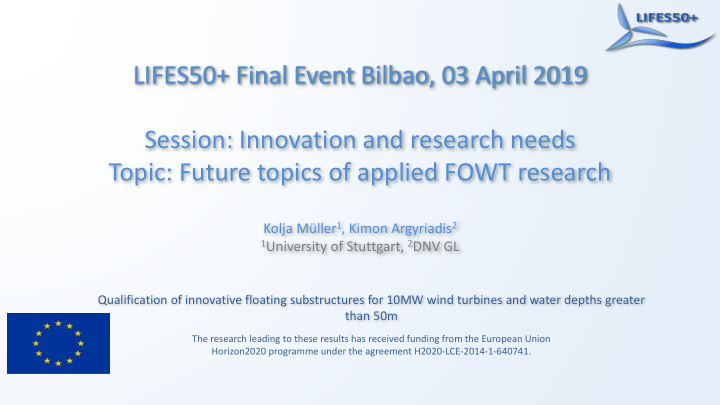



LIFES50+ Final Event Bilbao, 03 April 2019 Session: Innovation and research needs Topic: Future topics of applied FOWT research Kolja Müller 1 , Kimon Argyriadis 2 1 University of Stuttgart, 2 DNV GL Qualification of innovative floating substructures for 10MW wind turbines and water depths greater than 50m The research leading to these results has received funding from the European Union Horizon2020 programme under the agreement H2020-LCE-2014-1-640741.
Outline 1. LIFES50+ Targets and follow-up steps 2. Experimental & numerical evaluations 3. Design methodology & guidelines 4. Data considerations How to improve tools? How to improve component design? 1) LCOE 2) Risks How to demonstrate reliability of power supply? 3) Carbon footprint How to design floating wind farms? How to enable systems engineering? 03 April 2019 3
LIFES50+ Targets and follow-up steps Project objectives Increase to • Optimize and qualify TRL 6-7, to TRL 5 two innovative experimental 10MW designs evaluation • Develop evaluation and qualification procedures Improve for floating structures models / tools / methods / Next steps? standards • Full scale demonstrators • Analyze new Improve state-of-the-art • designs using New concepts using LIFES50+ LIFES50+ as reference procedure 03 April 2019 5
2. Experimental & numerical evaluations 03 April 2019 7
Experimental evaluation POLIMI Validation : • Consideration of experimental uncertainties Calibration : SINTEF • Standardized procedures Extreme scenarios : • Reproduction of complex hydro- and aerodynamic phenomena Full scale validation • Design assumptions • Scalability of model test results • Requirements / standardized procedures IDEOL 03 April 2019 8
Numeric evaluation NAUTILUS Develop existing tools Olav OLSEN • Substructure elasticity • Substructure CFD • Cables, Mooring lines • Aerodynamics • Larger wind turbines (20MW) Establish new tools • Wind farm design • Controller design • Process simulation DTU USTUTT Systems engineering 03 April 2019 10
3. Design methodology & guidelines 03 April 2019 11
Design methodology Safety Factors Structural reliability analysis Structural Updated safety reliability factors analysis 03 April 2019 12
Guidelines Update of the standards and supporting documents focusing on floating wind systems • FOWT System design – Site assessment requirements – Review of design requirements, safety factors, control systems – Transport and installation conditions – Analysis tools and requirements for analysis – DLC implementation. ULS, FLS, ALS • Floating wind farm level design • FOWT specific component design – Cables – Mooring lines 03 April 2019 14
4. Data considerations 03 April 2019 19
Data sharing Global constraint: technical viability Carbon Footprint Systems Engineering / Risk Multidisciplinary design optimization • Cost Requires quantified constraints, parameters, variables, KPIs Parameters Planning & Development Variables To align and connect all stakeholders of Lifecycle phases Manufacturing the community, standardized & open data is required as benchmark & reference Installation • Environmental data • Simulation models, inputs & results Operation & • Experimental & full scale measurements Maintenance • Costs, risks and carbon footprints Decommissioning & Repowering 03 April 2019 20
Data driven design process 03 April 2019 21
Data driven design process 3 Share key 5 1 My data Upload data Consume 4 Original data data through Authorize application Veracity data fabric application 2 Data quality, enrichment Cleaning & Analytics & Enrich and and analytics are sold as enrichment predictions add-on services analyse data 22
THANK YOU! www.lifes50plus.eu The research leading to these results has received funding from the European Union Horizon2020 programme under the agreement H2020-LCE-2014-1-640741. 23
Recommend
More recommend